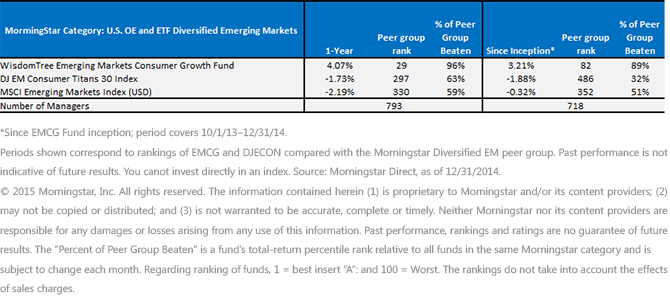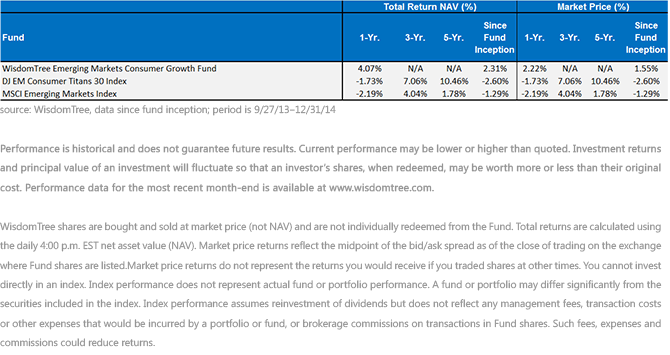Diamond in the Rough: The Emerging Markets Consumer Story

 Average Annual Returns as of 12/31/2014
Average Annual Returns as of 12/31/2014
 • Performance Drivers—Explaining EMCG’s Sector Exposure Compared with MSCI EM: The MSCI EM Index has more than 20% of its exposure in the Energy and Materials sectors, the two worst-performing sectors in the MSCI EM Index in 2014.3 EMCG, on the other hand, excludes the aforementioned sectors and instead has approximately 65% of its weight in domestic demand sectors4. We believe that these sectors are consistent with the theme of growth in the emerging markets’ middle class and are therefore supportive of domestic demand.
• EMCG for Income Potential: Even though EMCG weights according to net income, which results in a lower P/E ratio (EMCG P/E 11.9x; DJECON P/E 25.1x), EMCG’s 2.6% dividend yield offers an important income buffer for those seeking exposure to the emerging markets. EMCG’s dividend yield is a full 0.7% higher than that of DJECON and is comparable with the MSCI EM Index’s dividend yield.
• An Emphasis on Quality: EMCG’s valuation story is incomplete without a discussion of quality. EMCG’s underlying index methodology rewards companies that show promise in terms of return on equtity (ROE) and return on assets (ROA). This combination of ROE and ROA not only rewards companies that are highly efficient in utilizing their assets and equities to generate net income, it also penalizes companies that employ immense leverage in doing so. As a result, EMCG has the highest ROE and ROA, at 18.1% and 8.1% respectively, compared with DJECON (ROE 14.2%, ROA 5.8%) or MSCI EM Index (ROE: 11.6%, ROA: 2.4%).5
In conclusion, EMCG’s construction has resulted in a vehicle that has had more attractive valuations and a higher quality bias than its peers. Its broader sector focus, outside of the two regular consumer sectors, has helped provide diversification and offer a potentially more robust way to access the EM consumer.
1Source: Bloomberg, references the fact that the MSCI Emerging Markets Index has lagged the S&P 500 Index over the most recent three-year period from 12/31/11–12/31/14.
2Source: Morningstar; refers to 12/31/13–12/31/14.
3Sources: Bloomberg, WisdomTree, as of 12/31/14.
4Domestic demand sectors are Consumer Staples, Consumer Discretionary, Telecommunication Services, Utilities and Health Care.
5Source: Bloomberg, as of 12/31/14.
• Performance Drivers—Explaining EMCG’s Sector Exposure Compared with MSCI EM: The MSCI EM Index has more than 20% of its exposure in the Energy and Materials sectors, the two worst-performing sectors in the MSCI EM Index in 2014.3 EMCG, on the other hand, excludes the aforementioned sectors and instead has approximately 65% of its weight in domestic demand sectors4. We believe that these sectors are consistent with the theme of growth in the emerging markets’ middle class and are therefore supportive of domestic demand.
• EMCG for Income Potential: Even though EMCG weights according to net income, which results in a lower P/E ratio (EMCG P/E 11.9x; DJECON P/E 25.1x), EMCG’s 2.6% dividend yield offers an important income buffer for those seeking exposure to the emerging markets. EMCG’s dividend yield is a full 0.7% higher than that of DJECON and is comparable with the MSCI EM Index’s dividend yield.
• An Emphasis on Quality: EMCG’s valuation story is incomplete without a discussion of quality. EMCG’s underlying index methodology rewards companies that show promise in terms of return on equtity (ROE) and return on assets (ROA). This combination of ROE and ROA not only rewards companies that are highly efficient in utilizing their assets and equities to generate net income, it also penalizes companies that employ immense leverage in doing so. As a result, EMCG has the highest ROE and ROA, at 18.1% and 8.1% respectively, compared with DJECON (ROE 14.2%, ROA 5.8%) or MSCI EM Index (ROE: 11.6%, ROA: 2.4%).5
In conclusion, EMCG’s construction has resulted in a vehicle that has had more attractive valuations and a higher quality bias than its peers. Its broader sector focus, outside of the two regular consumer sectors, has helped provide diversification and offer a potentially more robust way to access the EM consumer.
1Source: Bloomberg, references the fact that the MSCI Emerging Markets Index has lagged the S&P 500 Index over the most recent three-year period from 12/31/11–12/31/14.
2Source: Morningstar; refers to 12/31/13–12/31/14.
3Sources: Bloomberg, WisdomTree, as of 12/31/14.
4Domestic demand sectors are Consumer Staples, Consumer Discretionary, Telecommunication Services, Utilities and Health Care.
5Source: Bloomberg, as of 12/31/14.Important Risks Related to this Article
There are risks associated with investing, including possible loss of principal. Foreign investing involves special risks, such as risk of loss from currency fluctuation or political or economic uncertainty. Funds focusing on a single sector and/or smaller companies generally experience greater price volatility. Investments in emerging, offshore or frontier markets are generally less liquid and less efficient than investments in developed markets and are subject to additional risks, such as risks of adverse governmental regulation, intervention and political developments. Due to the investment strategy of this Fund, it may make higher capital gain distributions than other ETFs. Please read the Fund’s prospectus for specific details regarding the Fund’s risk profile. Diversification does not eliminate the risk of experiencing investment losses. Short-term performance is not a good indication of the Fund’s future performance, and an investment should not be made based solely on returns. Neither MSCI nor any other party involved in or related to compiling, computing or creating the MSCI data makes any express or implied warranties or representations with respect to such data (or the results to be obtained by the use thereof), and all such parties hereby expressly disclaim all warranties of originality, accuracy, completeness, merchantability or fitness for a particular purpose with respect to any such data. Without limiting any of the foregoing, in no event shall MSCI, any of its affiliates or any third party involved in or related to compiling, computing or creating the data have any liability for any direct, indirect, special, punitive, consequential or any other damages (including lost profits) even if notified of the possibility of such.

